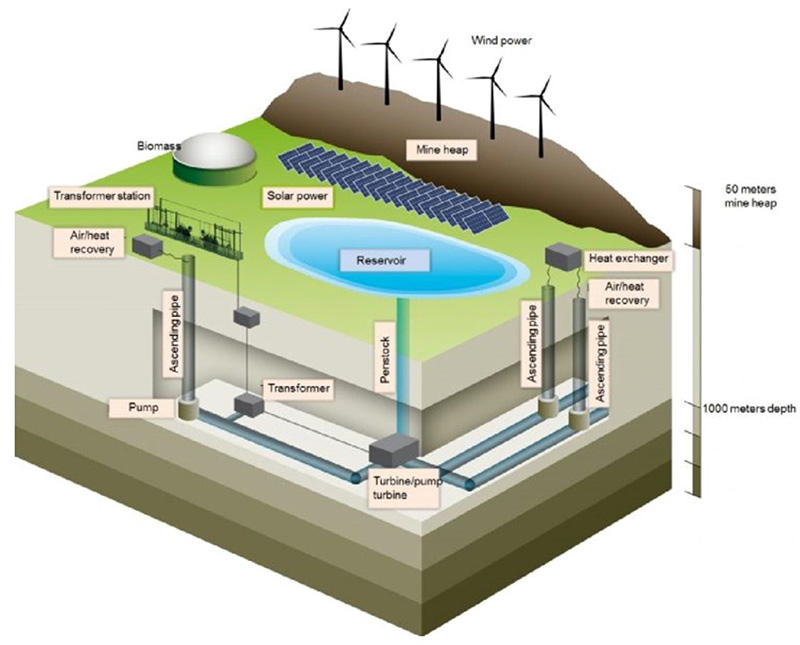
Sometimes we have too much electricity. But more often, grid operators are carefully managing its production to be sure that we have enough.
So, a lot of work has gone into trying to store excess electricity, to use later when we need it.
The obvious solution, giant batteries, is still too expensive for most applications and has environmental implications. This has led scientists to look for other ways.
One method uses surplus power to compress air and pump it into old salt mines. The salt tends to seal cracks in the walls, making the mines airtight.
When needed, the compressed air can be released to turn a turbine. Or it can be used as the intake air for a natural gas power plant, making the plant more productive.
Another way to store excess energy is to pump water uphill, into existing reservoirs, and then release it through hydroelectric dams when power is needed.
This method was pioneered 100 years ago in Italy and Switzerland, and is used today around the world, and in many U.S. states like Michigan.
On the Chilean coast, they’re even experimenting with using solar energy to pump seawater up a cliff, where it could flow down to make power at night.
These solutions don’t make economic sense unless the electricity is very cheap, and the reservoir was already built for another purpose.
But when those two things are present, pumping air and water to store energy plays a valuable role in balancing the grid to meet our ever-changing power demands.
Background
Synopsis: We tend to take electricity for granted—it’s there when we need it. But it doesn’t just come from the wall: electric-grid operators generate electricity as demand ramps up each day by accessing multiple sources for load balancing.
- When we need electricity, all we have to do is flip a switch.
- The grid transmits electricity instantaneously when we demand it.
- To avoid power blackouts, grid operators must have teams of people dedicated to predicting demand and generating the right amount of power from many different sources for peak loads.
- Electrical sources for power grids include steam, water, or wind to turn turbines.
- Solar-panel arrays are another type of electrical source.
- Clean electricity from renewable sources is often intermittent and produced at the wrong time for helping with peak loads.
- Water, oil, and gas can be stored in reservoirs or tanks to provide backup whenever needed. But how can we store electrical power for use when needed?
- Some electric-grid operators have created huge hydroelectric or compressed-air “batteries” for load balancing by using excess power available during low-demand periods to move water or air into abandoned mines, caverns, or reservoirs—essentially “storing” potential energy for turning turbines when demand is high.
- Compressed Air Energy Storage (CAES) uses excess electricity from the grid during low-demand periods to pump air into airtight underground caverns, typically abandoned salt caverns.
- Typical power plants have to consume about half of the electricity they generate to quickly compress air and enable combustion of natural gas that produces steam for the turbines.
- In Alabama, one power cooperative has for decades used compressed-air storage to enhance its load balancing.
- At night, cheap excess electricity from the grid is used to pump air into a huge salt cavern directly below the plant; during the day, the compressed air is released and heated for combustion with natural gas.
- Since the air is already compressed, the plant does not have to use expensive peak-demand natural gas for compression; thus, it costs less to produce the same amount of energy compared with typical plants.
- Renewable energy sources can also be used for compression, reducing natural-gas requirements.
- When energy is stored as compressed air, it heats up, and scientists researching more efficient ways to use CAES want to find out how to conserve that heat.
- Their new formula includes a crushed rock “heat store” chamber that holds the heat on the way into the cavern and then reheats the air as it is released for combustion with the gas—enhancing steam production and nearly doubling electricity generation.
- Currently, these projects occur within salt caverns because salt is nonreactive with air and tends to seal any cracks it develops. But researchers are also looking into re-using preexisting tunnels and mine shafts since new excavation would be too costly. Materials-engineering studies are underway to develop membranes that can be used to seal other types of underground chambers so they are airtight.
- Pumped Storage Hydroelectricity (PSH) uses falling water to generate power during peak demand, then pumps the water back “uphill” into existing reservoirs when surplus electricity is available, creating gravitational potential energy.
- PSH, the most cost-effective way to store power, was first used more than 100 years ago in mountainous places like Italy and Switzerland.
- Currently, China, Japan, and the United States have the largest power capacity from PSH, but new projects in other countries demonstrate amazing creativity.
- A new hydroelectric power-generation plant is under construction in one of the driest places on Earth—Chile’s Atacama Desert. The facility will use solar power to pump Pacific seawater into existing depressions at the top of a coastal cliff, and then generate electricity for industrial use as the water flows more than 1,800 ft back down to sea.
- A defunct coal mine in western Germany will use solar and wind power to pump water to higher levels in the mine and generate electricity as that water drops more than 3,600 ft to the mine’s lower levels. This is the first in a series of conversions in the region.
- Getting electricity to consumers the instant they demand it is a gargantuan task; engineers and scientists provide cost-efficient solutions that make our world run—even if we don’t notice it each day!

